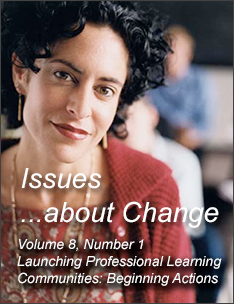Shared Personal Practice
Research indicates that teacher interaction within a formalized structure for collegial coaching is a powerful contributor to professional learning communities. In such interactions, teachers may visit other teachers' classrooms on a regular basis to provide encouragement and feedback on new instructional practices. As "peers helping peers" (Hord, 1997), teachers build a culture of mutual respect and trustworthiness for both personal and total school improvement.
Shared personal practice is often the last dimension to be developed. It is relatively uncommon for school staff to share their classroom practice with their peers in a formalized setting with the intent to improve and change their own classroom practice. It is more common for school staff to informally share successes, frustrations, and solutions with their colleagues. The Co-Developers' stories provided few instances in which teachers in their schools were using formalized procedures for this purpose. The Co-Developer stories were categorized into two areas:
- prerequisites for professional sharing, and
- determining ways to share.
Prerequisites for Professional Sharing
The fact that this dimension is usually the last to develop indicates that pre-existing conditions need to be in place before school staffs can be expected to share what is traditionally the private domain of teachers — their instructional practices. Co-Developers recognized that teachers had to have a high degree of trust before engaging in reflective discussion of their personal practices. Although some teachers may value the opinions of their colleagues and may accept the benefit that this practice would have for professional growth, examining personal practice is perceived as a risky undertaking.
In one instance, a Co-Developer acknowledged the necessity of this pre-existing relationship and the need to build a foundation of trust before addressing this dimension significantly.
The initial discussion of shared practice was very tentative. While a few of the leadership team members expressed a need for this, they also stated that this happened rarely within the school culture. The leadership team believed that more trust and collaboration would have to be built before moving into this attribute. (Co-Developer H)
Determining Ways to Share
Co-Developers reported that principals play an important role in establishing expectations for shared personal practice. At one site, the Co-Developer observed the principal encouraging this practice by suggesting a variety of ways in which it could be done.
The principal was encouraging teachers to observe in one another's classes and video themselves, to be reflective, and to look at action research as a way to improve classroom practice and student outcomes. (Co-Developer I)
At another site, teachers were beginning to recognize the value of visiting other classrooms.
Teachers give informal/formal feedback when they see others "on the right track." Visiting between classes occurs, i.e., second grade teachers visiting third grade classes. Teachers would like to see more sharing between fifth and sixth grade classes and believe that it should be more than a "one-day shot." New teachers are allowed to visit each grade level to find their "niche" in the organization. (Co-Developer S)
Next Page: Conclusion and References

